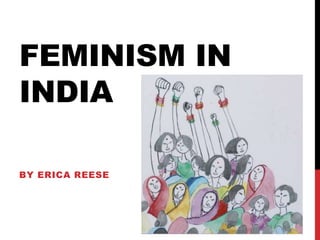
Feminism in india
- 1. FEMINISM IN INDIA BY ERICA REESE
- 2. BRIEF BACKGROUND • For many years, India relied on a Caste system. • Currently issues of severe poverty coupled with the extreme wealth. • 48% women. • Women make 22% of the labor force. • Women make up 85.5% of agricultural labor.
- 4. PHASE ONE • Phase one is marked Britain's colonization of India in around 1850 • Conversion from Hinduism to Christianity is a complex matter, with a lot of gender differences. • Women following men, or women attempting a reprieve strict gender roles associated with Hinduism. • Often criticized for being started by British missionaries and converts. • Worked to Combat Sati, infanticide, property rights, and education. Also strict gender roles of Hindi tradition was addressed.
- 5. PHASE 2 • Phase two is marked by Ghandi’s resistance to the British Reign • Ghandi allowed women to participate in resistance to the British Raj, giving them the public sphere. Said to be the start of “true” feminsim. • Creation of AIWC and NFIW • Education, working class women, very anti-colonial.
- 6. FIVE YEAR PLAN • A type of welfare system designed to empower women through means of education, health care, and other aid. • Became an “inclusionary” system, meaning women were included in the process as participants instead of recipients. • Paved way for other women’s organizations from there on.
- 7. PHASE 3 • Marked by India’s independence from Britain in 1947 until now. • Sexual divide in workplace, class consciousness, patriarchy within religious law, female infanticide, violence against women.
- 9. WOMEN IN POVERTY • The Dalit movement -Dalits banned together in order to address issues within impoverished areas such as inequality in labor, women being used as “cheap capitol”, lack of education and the high rates of violence against women. • Mahila Samakhya Karnataka (MSK) program. • Uses inclusionary methods. • Education programs for women and children • Poverty alleviation programs • Programs designed specifically for rural women
- 10. CRITIQUES OF THE DALIT MOVEMENT • Has not been able to efficiently address the problem of sexual violence • Is mostly facilitated by upper class women, and therefore upper class ideas are a heavy influence of a group of people who may not want to engage.
- 11. SON PREFERANCE AND SEX-SELECTIVE ABORTIONS • Strong patrilineal traditions in some areas of India have caused men to desire a male child. • Dowry also plays a role. • Women are often seen as a burden. • Sex-Selective abortions are often coerced or forced by husbands, family members or the community itself. • If abortion is not the route taken, female children often become neglected in these types of circumstances. • Sex ratio has declined.
- 12. SON PREFERENCE CON’T.. • Organizations designed to stop sex selective abortions in India tend to be Christian organizations from the United States. • Rely on the ideal that abortion itself is wrong rather than trying to fight against the underlying cause of the abortions happening in India in this context.
- 13. SEX TRAFFICKING • There isn’t an exact number of how many women are trapped in the sex slave trade in India, but it is in the upper millions. • Brothels are in a massive scale. Prostitution is not considered legal in India however, it is often over looked by authority. • There is a divide between feminists who say sex trafficking may carry too negative of a connotation when considering women who chose sex work for themselves. • There are still a large number of women and children enslaved against their will in order to continue brothels around India.
- 14. INTERNATIONAL JUSTICE MISSION (IJM) • Possibly the most known and arguably successful anti sex trafficking organization. • Has social workers, lawyers and government authority forces working for them • Four point model • Relief, Perpetrator Accountability, Aftercare, Governmental transformation
- 15. SEX TRAFFICKING CON’T… Even though there are multiple large organizations that fight against sex trafficking, getting women out of the brothels is extremely difficult. • Most have been involved since birth and often see it as normal life. • Once out of the brothels, work is impossible or at least scarce to find due to Dalit status. • Owners of the brothel’s are often dangerous and know where to hide women.
- 16. INDIAN FEMINISM PROS AND CONS Pros • Has sense of collectiveness rather than individuality. • Importance of “motherhood.” Cons • Critiqued for having too much western influence • Critiqued for focusing too much on upper class women’s needs and ignoring lower classes, generally.
- 17. WORKS CITED Anagol, Padma. The Emergence of Feminism in India: 1850- 1920. Aldershot: Ashgate, 2005. Print. Ganesamurthy, V. S. Empowerment of Women in India: Social, Economic, and Political. New Delhi: New Century Publications, 2008. Print. Subramaniam, Mangala. The Power of Women's Organizing: Gender, Caste, and Class in India. Lanham, MD: Lexington, 2006. Print. “International Justice Mission |." International Justice Mission |. Web. 08 Apr. 2012. <http://www.ijm.org/>.
